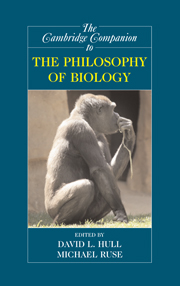Book contents
- Frontmatter
- 1 Adaptation
- 2 Population Genetics
- 3 Units and Levels of Selection
- 4 What’s Wrong with the Emergentist Statistical Interpretation of Natural Selection and Random Drift?
- 5 Gene
- 6 Information in Biology
- 7 Reductionism (and Antireductionism) in Biology
- 8 Mechanisms and Models
- 9 Teleology
- 10 Macroevolution, Minimalism, and the Radiation of the Animals
- 11 Philosophy and Phylogenetics: Historical and Current Connections
- 12 Human Evolution: The Three Grand Challenges of Human Biology
- 13 Varieties of Evolutionary Psychology
- 14 Neurobiology
- 15 Biological Explanations of Human Sexuality: The Genetic Basis of Sexual Orientation
- 16 Game Theory in Evolutionary Biology
- 17 What Is an ‘Embryo’ and How Do We Know?
- 18 Evolutionary Developmental Biology
- 19 Molecular and Systems Biology and Bioethics
- 20 Ecology
- 21 From Ecological Diversity to Biodiversity
- 22 Biology and Religion
- 23 The Moral Grammar of Narratives in History of Biology: The Case of Haeckel and Nazi Biology
- Reference List
- Index
- Series List
2 - Population Genetics
Published online by Cambridge University Press: 28 April 2008
- Frontmatter
- 1 Adaptation
- 2 Population Genetics
- 3 Units and Levels of Selection
- 4 What’s Wrong with the Emergentist Statistical Interpretation of Natural Selection and Random Drift?
- 5 Gene
- 6 Information in Biology
- 7 Reductionism (and Antireductionism) in Biology
- 8 Mechanisms and Models
- 9 Teleology
- 10 Macroevolution, Minimalism, and the Radiation of the Animals
- 11 Philosophy and Phylogenetics: Historical and Current Connections
- 12 Human Evolution: The Three Grand Challenges of Human Biology
- 13 Varieties of Evolutionary Psychology
- 14 Neurobiology
- 15 Biological Explanations of Human Sexuality: The Genetic Basis of Sexual Orientation
- 16 Game Theory in Evolutionary Biology
- 17 What Is an ‘Embryo’ and How Do We Know?
- 18 Evolutionary Developmental Biology
- 19 Molecular and Systems Biology and Bioethics
- 20 Ecology
- 21 From Ecological Diversity to Biodiversity
- 22 Biology and Religion
- 23 The Moral Grammar of Narratives in History of Biology: The Case of Haeckel and Nazi Biology
- Reference List
- Index
- Series List
Summary
INTRODUCTION
Population genetics is a subfield of evolutionary biology that aims to represent mathematically the changes in the genetic variation of populations (specifically, sexually reproducing populations with Mendelian heredity) over time. The mathematical models of population genetics provide a theoretical basis for experimental studies of laboratory populations and studies of natural populations. Our primary focus in this essay is on population genetics theory itself, rather than its applications, although towards the end of the essay we give some discussion of the latter.
Population genetics attempts to measure the influence of the causes of evolution, namely, mutation, migration, natural selection, and random genetic drift, by understanding the way those causes change the genetics of populations. But how does it accomplish this goal? We begin in Section 2 with a brief historical outline of the origins of population genetics. In Section 3, we sketch the model theoretic structure of population genetics, providing the flavor of the ways in which population genetics theory might be understood as incorporating causes. In Sections 4 and 5 we discuss two specific problems concerning the relationship between population genetics and evolutionary causes, namely, the problem of conceptually distinguishing natural selection from random genetic drift, and the problem of interpreting fitness. In Section 6, we briefly discuss the methodology and key epistemological problems faced by population geneticists in uncovering the causes of evolution. Section 7 of the essay contains concluding remarks.
- Type
- Chapter
- Information
- The Cambridge Companion to the Philosophy of Biology , pp. 22 - 43Publisher: Cambridge University PressPrint publication year: 2007
- 8
- Cited by



